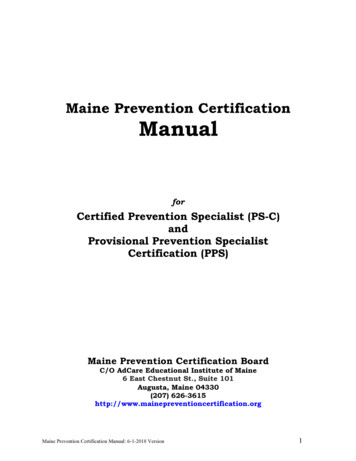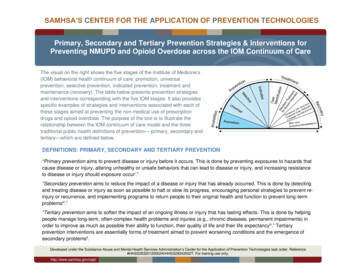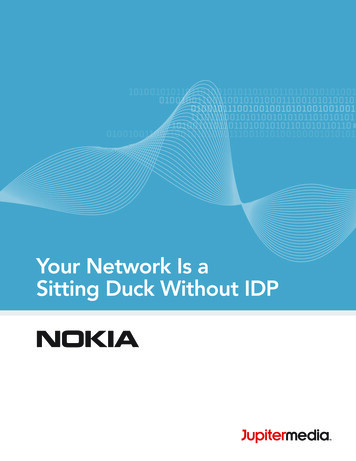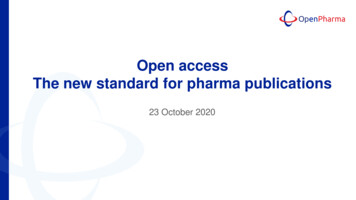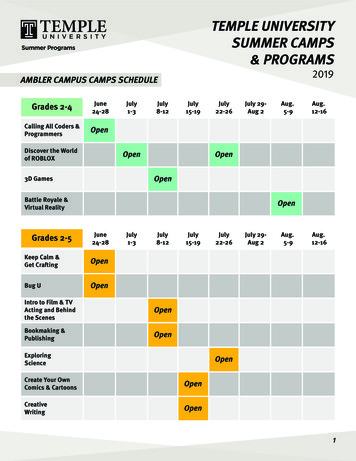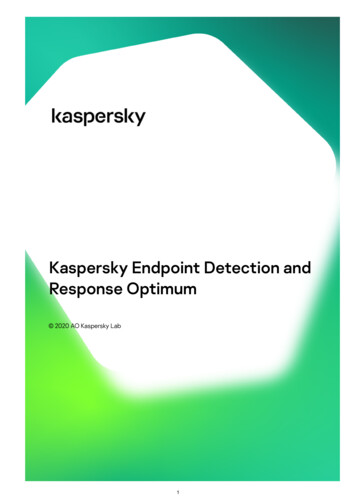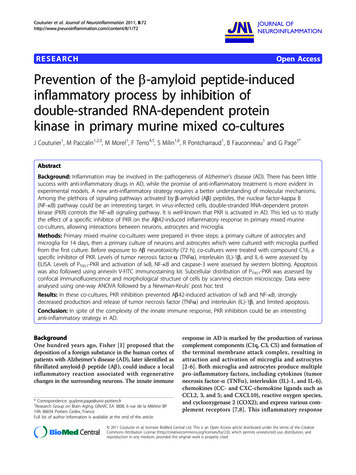
Transcription
Couturier et al. Journal of Neuroinflammation 2011, 72RESEARCHJOURNAL OFNEUROINFLAMMATIONOpen AccessPrevention of the b-amyloid peptide-inducedinflammatory process by inhibition ofdouble-stranded RNA-dependent proteinkinase in primary murine mixed co-culturesJ Couturier1, M Paccalin1,2,3, M Morel1, F Terro4,5, S Milin1,6, R Pontcharraud1, B Fauconneau1 and G Page1*AbstractBackground: Inflammation may be involved in the pathogenesis of Alzheimer’s disease (AD). There has been littlesuccess with anti-inflammatory drugs in AD, while the promise of anti-inflammatory treatment is more evident inexperimental models. A new anti-inflammatory strategy requires a better understanding of molecular mechanisms.Among the plethora of signaling pathways activated by b-amyloid (Ab) peptides, the nuclear factor-kappa B(NF- B) pathway could be an interesting target. In virus-infected cells, double-stranded RNA-dependent proteinkinase (PKR) controls the NF- B signaling pathway. It is well-known that PKR is activated in AD. This led us to studythe effect of a specific inhibitor of PKR on the Ab42-induced inflammatory response in primary mixed murineco-cultures, allowing interactions between neurons, astrocytes and microglia.Methods: Primary mixed murine co-cultures were prepared in three steps: a primary culture of astrocytes andmicroglia for 14 days, then a primary culture of neurons and astrocytes which were cultured with microglia purifiedfrom the first culture. Before exposure to Ab neurotoxicity (72 h), co-cultures were treated with compound C16, aspecific inhibitor of PKR. Levels of tumor necrosis factor-a (TNFa), interleukin (IL)-1b, and IL-6 were assessed byELISA. Levels of PT451-PKR and activation of I B, NF- B and caspase-3 were assessed by western blotting. Apoptosiswas also followed using annexin V-FITC immunostaining kit. Subcellular distribution of PT451-PKR was assessed byconfocal immunofluorescence and morphological structure of cells by scanning electron microscopy. Data wereanalysed using one-way ANOVA followed by a Newman-Keuls’ post hoc testResults: In these co-cultures, PKR inhibition prevented Ab42-induced activation of I B and NF- B, stronglydecreased production and release of tumor necrosis factor (TNFa) and interleukin (IL)-1b, and limited apoptosis.Conclusion: In spite of the complexity of the innate immune response, PKR inhibition could be an interestinganti-inflammatory strategy in AD.BackgroundOne hundred years ago, Fisher [1] proposed that thedeposition of a foreign substance in the human cortex ofpatients with Alzheimer’s disease (AD), later identified asfibrillated amyloid-b peptide (Ab), could induce a localinflammatory reaction associated with regenerativechanges in the surrounding neurons. The innate immune* Correspondence: guylene.page@univ-poitiers.fr1Research Group on Brain Aging, GReViC EA 3808, 6 rue de la Milétrie BP199, 86034 Poitiers Cedex, FranceFull list of author information is available at the end of the articleresponse in AD is marked by the production of variouscomplement components (C1q, C3, C5) and formation ofthe terminal membrane attack complex, resulting inattraction and activation of microglia and astrocytes[2-6]. Both microglia and astrocytes produce multiplepro-inflammatory factors, including cytokines (tumornecrosis factor-a (TNFa), interleukin (IL)-1, and IL-6),chemokines (CC- and CXC-chemokine ligands such asCCL2, 3, and 5; and CXCL10), reactive oxygen species,and cyclooxygenase 2 (COX2); and express various complement receptors [7,8]. This inflammatory response 2011 Couturier et al; licensee BioMed Central Ltd. This is an Open Access article distributed under the terms of the CreativeCommons Attribution License (http://creativecommons.org/licenses/by/2.0), which permits unrestricted use, distribution, andreproduction in any medium, provided the original work is properly cited.
Couturier et al. Journal of Neuroinflammation 2011, 72aims to enhance the clearance of Ab by the phagocyticrole of both microglia and astrocytes. Although activationof the complement system or a lipopolysaccharide (LPS)treatment in amyloid precursor protein (APP) transgenicmice increases phagocytosis of Ab and might limitpathology by activating immune responses [8,9], the beneficial role of inflammation in AD does not seem to besufficient to halt or reverse the disease. It fails to slowprogression of the major histopathological hallmarks(amyloid plaques and neurofibrillar tangles) and cognitiveimpairment. The innate immunity system might be neuroprotective as far as phagocytosis is elicited, but later inthe disease proinflammatory responses could turn theinnate immunity into the driving force in ADpathogenesis.Increasing evidence suggests that inflammation significantly contributes to the pathogenesis of AD. It isknown that Ab oligomers and fibrils, as danger-associated molecular patterns (DAMPs), can interact withdifferent pattern recognition receptors (PRRs) such asscavenger receptors, toll-like receptors (TLRs), and thereceptor for advanced glycation end products (RAGE) inboth glial cells and neurons [10,11]. PRRs can triggerphagocytic uptake of Ab but also can induce proinflammatory signaling pathways such as I B kinase (IKK), Junkinase (JNK) p38 and glycogen synthase kinase 3b(GSK-3b) [10].Many cytokines such as TNFa and IL-1b, and chemokine signaling (CXCR2 signaling) can promote Ab production by modulating g-secretase activity in neurons[12,13]. Some studies have also demonstrated that IL-1binduces phosphorylation of tau protein and triggers formation of paired-helical filaments (PHFs) which aggregate into neurofibrillary tangles [14,15]. Inflammation inAD could also trigger functional impairment sinceinflammatory molecules such as TNFa, IL-1 and IL-6are able to suppress hippocampal long term potentiation[16,17]. Furthermore, many studies have shown a significant increase of various inflammatory mediators inplasma and in peripheral blood mononuclear cells(PBMCs) of patients with AD compared to age-matchedcontrols [18,19].In addition, many prospective epidemiological studieshave indicated that non-steroidal anti-inflammatorydrugs (NSAIDS) might delay the onset and the progression of AD [20]. However, clinical trials with COX-2inhibitors have yielded negative results, and the relevance of specific COX inhibitors and other NSAIDS hasbecome more and more questionable [21]. There aremany reasons to explain the failure of these trials: timing of treatment, dosing, and the specificities of administrated NSAIDS are the most frequently cited. A recentsmall, open-label pilot study suggested that inhibition ofthe inflammatory cytokine TNF-a with perispinalPage 2 of 17administration of etanercept, a potent anti-TNF fusionprotein, might lead to sustained cognitive improvementin patients with mild, moderate, or severe AD [22].These results need to be confirmed.The cellular and molecular components of the innateinflammatory response associated with slowly progressive degenerative disease are not clearly identified. Inthis response, Ab could involve different PRRs, activating protein kinases such as IKKs which trigger proinflammatory responses via nuclear factor-kappa B (NF B), known as the major transcriptional factor of a widerange of cytokines, that could in turn maintain NF- Bactivation and establish a positive autoregulatory loopthat could amplify the inflammatory response andincrease the duration of chronic inflammation [23]. Themodulation of NF- B activation in AD may be a neuroprotective strategy. A recent study revealed that an inhibitor of NF- B ameliorates astrogliosis but has no effecton amyloid burden in APPswePS1dE9 [24], probablydue to late timing of the treatment after the beginningof amyloid deposits. The IKK/NF- B signaling pathwayis under the control of other kinases, in particular thedouble-stranded RNA-dependent protein kinase (PKR),well described in AD and associated with degeneratingneurons and cognitive decline [12,25-30]. Indeed, in studies using different virus-infected cells, it has beenshown that PKR can phosphorylate IKK, which phosphorylates I B, leading to disruption of the cytosolic I BNF- B complex. This allows NF- B to translocate fromthe cytoplasm to the nucleus, where it binds to its specific sequences of DNA called response elements of thetarget genes, including those involved in the immuneresponse (IL-2), inflammatory response (TNFa, IL-1, IL6), cell adhesion (I-CAM, V-CAM, E-selectin) cell growth(p53, Ras, and c-Myc) and apoptosis (TNF receptor-associated factor 1 and 2) [31-33]. Furthermore, it has beenshown that TNF-induced NF- B activation, IKK activation, I Ba phosphorylation, I Ba degradation and NF B reporter gene transcription are all suppressed in PKRgene-deleted fibroblasts, underlining the fact that NF- Bis a downstream target of PKR [34].The aim of the present study was to determinewhether PKR can control activation of the NF- B pathway and cytokine production (TNF, IL-1b, and IL-6) inprimary mouse co-cultures that contain the three maincellular actors in brain: neurons, astrocytes and microglia. While neurons are traditionally passive bystandersin neuroinflammation, they are able to produce inflammatory mediators such as IL-1b, IL-6, TNFa [15,35,36].Although this integrated in vitro model does not correspond exactly to the brain environment, it includes themajor cell types of brain and maintains the interactionsbetween these three cellular actors which could modulate the inflammatory response of each one.
Couturier et al. Journal of Neuroinflammation 2011, 72For this purpose, before exposure to Ab neurotoxicity,co-cultures were treated with compound C16, a specificinhibitor of PKR [37]. Analysis of results shows thatinhibition of PKR prevents activation of NF- B, associated with a strong decrease in production and releaseof TNFa and IL-1b, and limited apoptosis. Keeping inmind the complexity of the innate immune response,inhibition of PKR could be an interesting strategy to rescue the inflammatory process in AD.MethodsChemical productsSodium fluoride (NaF), phenylmethylsulfonyl fluoride(PMSF), protease and phosphatase inhibitor cocktails,dithiothreitol (DTT), 0.01% poly-L-lysine solution, Percoll , sterile filtered dimethylsulfoxide Hybri-Max (DMSO), Triton X-100, paraformaldehyde (PFA), annexinV-fluorescein isothiocyanate (FITC) apoptosis detection kit and all reagent-grade chemicals for buffers werepurchased from Sigma (St Quentin Fallavier, France);DMEM (1 g/L), MEM and Neurobasal media, B-27 Supplement, 200 mM L-glutamine, 5,000 units of penicillin(base) and 5,000 μg of streptomycin (base)/mL (PS) mixture, 0.5 g/L Trypsin/0.2 g/L EDTA 4Na, Fetal BovineSerum, Certified (FBS), Horse Serum, NuPAGE Novex Bis-Tris Mini Gels, NuPAGE LDS 4X LDSSample Buffer, NuPAGE Sample Reducing Agent(10X), NuPAGE MES SDS Running Buffer andNuPAGE Antioxidant, iBlot Gel Transfer Device(EU), the Prolong Gold antifade reagent with 4’,6-diamidino-2-phenylindole (DAPI) and the Zenon mouse IgGlabelling kit from Gibco-Invitrogen (Fisher BioblockScientific distributor, Illkirch, France); the imidazolooxindole compound C16 from Merck Chemicals Calbiochem (Nottingham, UK). For western blot, primaryantibodies and secondary anti-rabbit IgG antibody conjugated with horseradish peroxydase were purchasedfrom Cell Signalling (Ozyme, St Quentin Yvelines,France) excepted anti-PT451-PKR from Eurogentec (Seraing, Belgium), anti-b tubulin and anti-b actin fromSigma (St Quentin Fallavier, France), anti-amyloid peptide (clone WO2, recognizes amino acids residues 4-10of Ab) from Millipore (St Quentin-Yvelines, France),peroxidase-conjugated anti-mouse IgG from AmershamBiosciences (Orsay, France). For immunofluorescence,anti-glial fibrillary acidic protein (GFAP) antibodieswere purchased from Cell Signalling (Ozyme, St Quentin Yvelines, France), microtubule associated protein 2(MAP2) from Abcam (Paris, France), macrosialin ormurine homologue of the human CD68 from AbD Serotec (Düsseldorf, Germany), anti-P T451 -PKR from Biosource (Nivelles, Belgium), secondary antibodies fromDakoCytomation, (Trappes, France) and IgG- and protease-free bovine serum albumin (BSA) from JacksonPage 3 of 17ImmunoResearch Europe Ltd (Interchim distributor,Montluçon, France).Primary murine mixed neuron-astrocyte-microgliaculturesFirst, primary glial cultures were prepared from C57BL/6J mouse embryos of 18 days. Brains were quicklyremoved, and cerebral cortico-hippocampal regionswere dissected in ice-cold and sterile 1X PBS (154 mMNaCl, 1.54 mM KH2PO4, 2.7 mM Na2HPO4 7H2O, pH7.20 0.05) containing 18 mM glucose and 1% PS aspreviously described [38]. Cells were then dissociatedmechanically using a pipette into DMEM/1% PS, transferred into tubes containing FBS at the bottom (1 mL/30 mL cell suspension) and centrifuged at 300 g for10 min at 4 C. The cell pellet was suspended intoDMEM/1% PS and centrifuged again. This step wasrepeated once. After the centrifugation, cells were suspended into DMEM/10% FBS/1% PS, seeded at a densityof 4 10 5 cells/mL in Nunc EasYFlask (75 cm 2 )coated with 0.001% poly-L-lysine and then incubated at37 C in a humidified 5% CO2 atmosphere. Medium wasreplaced every five days. These cells were cultured untilday 14, the day of microglia purification.Second, primary cultures with neurons and astrocyteswere prepared from cortex and hippocampus of C57BL/6J mouse embryos of 18 days as above. Cells were suspended in MEM/Neurobasal (1:1) supplied with 18 mMglucose, B-27 Supplement, 1% glutamine, 2.5% FBS,2.5% horse serum and 1% PS, and seeded in 6-wellplates (106 cells per well) coated with 0.001% poly-Llysine. Cultures were then maintained at 37 C in ahumidified 5% CO2 atmosphere. At day 5, neurons andastrocytes were cultured with microglia purified fromthe primary culture described above.Third, microglia were purified from glial cultures onday 14 as previously described with some modifications[39]. Briefly, confluent glial cultures were dissociatedwith trypsin/EDTA and cell suspensions were suspendedin 1 mL of 70% isotonic Percoll and transferred into a 5ml glass tube. Two mL of 50% isotonic Percoll weregently layered on top of the 70% layer and then 1 mL of1X PBS layered on top of 50% isotonic Percoll layer.Tubes were centrifuged at 1200 g for 45 min at roomtemperature (RT) with a program including minimumacceleration and brake in a swinging bucket rotor.Purified microglia occupied the interface between 70and 50% isotonic Percoll. The top interface between 1XPBS and 50% isotonic Percoll containing all other central nervous system (CNS) elements was carefullyremoved and microglia layer was transferred into a newtube and washed twice by adding 1 mL PBS and centrifuged at 500 g for 5 min at RT. Cells were countedand seeded at the density of 150,000 cells per well into
Couturier et al. Journal of Neuroinflammation 2011, 726-well plates containing the primary culture of neurons/astrocytes to 5 days old in order to obtain a density ofmicroglia close to that already described. Indeed, thedensity of microglia in the CNS of the normal adultmouse brain is variable depending on the brain regionand represents 5% in the cerebral cortex, according toLawson et al. [40]. The mixed murine co-cultures withneurons, astrocytes and microglia were then used threedays later for experiments and a fourfold confocal staining with cell and nucleus markers (DAPI, MAP-2, GFAP,CD68 for nuclei, neurons, astrocytes and microglia,respectively) was investigated in cells seeded on poly-Llysine-coated glass coverslips to quantify neurons, astrocytes and microglia. In additional file 1, figure S1, weshow that neurons, astrocytes and microglia representabout 36, 57 and 6% of total cells, respectively, i.e. closeto what is physiologically observed in the cortex.Chemical treatmentsCo-cultures were treated with either C16 (specific inhibitor of PKR) at different concentrations (210 nM (IC50)and 1 μM) or DMSO (vehicle of C16) at less than 1%, inserum-free MEM:Neurobasal (1:1)/1% glutamine/1% PSmedium 1 hour before 20 μM Ab42 (or exactly 11 nmolin 550 μL of medium in each well receiving Ab42) for 72h at 37 C. Ab42 was previously incubated 48 h at 37 Cfor aggregation as recommended by the Merck Chemicalsupplier [41]. The concentration of Ab42 was chosenbased on previous work in primary cultures [38,42]. Aftertreatment, media were conserved in order to analyseAb42 monomers and oligomers by immunoblotting andfibrillar form of Ab42 by scanning electron microscopyin our experimental conditions (see the additional file 2,Figure S2). Results show the presence of a mix composedwith monomers, oligomers (8 and 12 kDa) and a densenetwork of fibrils. As the specific toxicity of these different states of Ab is not clearly demonstrated, we decidedto incubate cells with this whole mixture.Cell lysis and nuclear extractsAfter treatment, media were stored at -80 C until usedfor ELISA of cytokines. Cells were then washed withPBS and lysed in ice-cold lysis buffer (50 mM Tris-HCl,50 mM NaCl pH 6.8, 1% (v/v) Triton X-100, 1 mMPMSF, 50 mM NaF, 1% (v/v) protease inhibitor and 1%(v/v) phosphatase inhibitor cocktails). Lysates were sonicated for 10 sec and centrifuged at 15,000 g for 15min at 4 C. The supernatants were collected and analyzed for protein determination using a protein assay kit(Biorad, Marnes-la-Coquette, France). Samples were frozen at -80 C until further analysis.Nuclear extracts were prepared as previously described[43]. Firstly, the cytoplasmic fraction was isolated anddiscarded, and the nuclear pellet was then lysed inPage 4 of 17nuclear lysis buffer (20 mM Hepes pH 7.9, 400 mMNaCl, 1 mM EDTA, 1 mM EGTA, 1 mM DTT, 0.5 mMPMSF, 1% of protease and 1% phosphatase inhibitorcocktails) during 2 h at 4 C. Then, vials were centrifuged at 1,600 g for 5 min at 4 C and the supernatantwas isolated. The quantity of total protein was measuredwith a Biorad protein assay kit.Enzyme-linked immunosorbent assay (ELISA)Commercially available ELISA kits were used for assessing TNFa (sensitivity: 2 pg/mL), IL-1b (sensitivity: 15pg/mL) and IL-6 (sensitivity: 2 pg/mL) according to themanufacturers’ instructions (BioLegend, Ozyme, StQuentin Yvelines, France). The range of analysis wasbetween 7.8-6000 pg/mL. Cell lysates were diluted (1:2)with the assay diluents and all steps were performed atRT. The enzymatic reaction was stopped after 15 minincubation with tetramethylbenzidine (TMB) substrateby adding 2N H2SO4 and the optical density (OD) wasread at 450 nm within 30 min, using the Multiskan spectrum spectrophotometer. The cytokine levels werethen calculated by plotting the OD of each sampleagainst the standard curve. The intra- and inter-assayreproducibility was 90%. OD values obtained forduplicates that differed from the mean by greater than10% were not considered for further analysis. For convenience all results are expressed in pg/mL and in pg/mgprotein for culture medium and cell lysates, respectively.ImmunoblottingSamples (30 μg proteins of cell lysates or nuclearextracts) were prepared for electrophoresis by addingNuPAGE LDS 4X LDS sample buffer and NuPAGE Sample Reducing Agent (10X). Samples were thenheated up 100 C for 5 min and loaded into NuPAGE Novex Bis-Tris Mini Gels, and run at 200 V for 35min in NuPAGE MES SDS running buffer containing0.5% NuPAGE antioxidant. Gels were transferred tonitrocellulose membranes using the iBlot Dry blottingsystem set to program 20V for 7 min. Membranes werewashed for 10 min in Tris-buffered saline/Tween(TBST: 20 mM Tris-HCl, 150 mM NaCl, pH 7.5, 0.05%Tween 20) and blocked 2 h in TBST containing 5% nonfat milk or 5% bovine serum albumin (BSA).Blots were incubated with primary antibody in blocking buffer overnight at 4 C. Antibodies used were rabbitanti-PT451-PKR (1:100), mouse anti-PS32/36-I B (1:500),rabbit anti-I B (1:500), rabbit anti-P S536 -NF- Bp65(1:500), rabbit anti-NF- Bp65 (1:500) and rabbit anticaspase3 8G10 (1:500) which detects endogenous levelsof full-length and large fragments of caspase-3 resultingfrom cleavage at aspartic acid 175. Membranes werewashed 2 times with TBST and then incubated with theperoxidase-conjugated secondary antibody either anti-
Couturier et al. Journal of Neuroinflammation 2011, 72rabbit or anti-mouse IgG (1:1000) according to the origin of primary antibody during 1 hour at RT. Membranes were washed again and exposed to thechemiluminescence ECL luminol plus western blottingsystem (Amersham Biosciences, Orsay, France) followedby signal capture with the Gbox system (GeneSnap software, Syngene, Ozyme distributor). After 2 washes inTBST, membranes were probed with mouse antibodyagainst tubulin (1:10000) or actin (1:100000) overnightat 4 C. They were then washed with TBST, incubatedwith peroxidase-conjugated secondary antibody antimouse (1:1000) for 1 h, exposed to the chemiluminescence ECL luminol western blotting system and signalswere captured. Automatic image analysis software wassupplied with Gene Tools (Syngene, Ozyme distributor).Ratios protein/tubulin or actin were calculated and areshown in the corresponding figures.ImmunofluorescenceAfter treatment, cells on coverslips were washed oncewith PBS and fixed with 4% PFA for 15 min at RT.After three washes with PBS, the permeabilizing andblocking PBS buffer (137 mM NaCl, 2.7 mM KCl, 1.7mM KH2PO4, 10.14 mM Na2HPO4, pH 7.4 containing0.3% triton X-100 and 5% of IgG- and protease-freeBSA) was added during 1 h at RT.Staining of neurons, astrocytes and microglia was performed by incubating coverslips overnight at 4 C with amix containing rabbit anti-MAP2 (1:50), mouse antiGFAP (1:100) and rat anti-CD68 (1:25) in PBS containing 0.3% triton X-100 and 1% of BSA. Cells were thenrinsed twice with PBS before 1 h incubation at RT withthe mix containing secondary antibodies: swine anti-rabbit FITC (1:20), goat anti-mouse AlexaFluor 647 (1:25)and goat anti-rat R-Phycoerythrin (RPE) (1:25) dilutedin PBS/0.3% triton X-100/1%BSA. Finally, cells werewashed twice in PBS and twice in distilled water beforeusing the Prolong Gold antifade reagent with DAPI.Staining of PT451-PKR and cell marker (MAP2, GFAPor CD68) was performed in PBS/0.3% triton X-100/1%BSA overnight at 4 C by using rabbit anti-P T451-PKR(1:25) with chicken anti-MAP2 (1:100) and mouse antiGFAP (1:100). After incubation, cells were washed twicewith PBS before incubated with swine anti-rabbit (1:30)conjugated with tetramethylrhodamine isomer R(TRITC), goat anti-chicken FITC (1:50) and goat antimouse AlexaFluor 647 (1:25) for 1 h at RT. A sequentiallabelling for P T451 -PKR and CD68 was performed.Firstly, cells were incubated with anti-CD68 antibodiesovernight at 4 C, washed and incubated with goat antirat RPE. Secondly, cells were incubated with anti-PT451PKR overnight at 4 C, washed and incubated with swineanti-rabbit FITC (1:20). Finally, coverslips were washedand mounted as described above.Page 5 of 17Annexin V-FITC labels phosphatidylserine sites on themembrane surface. The kit used also includes propidiumiodide (PI) to label cellular DNA in necrotic cells wherethe cell membrane has been totally compromised. Forthis labelling, cells were incubated with annexinV-FITC(1:50) and PI (1:100) in 1X binding buffer for 10 min atRT. Cells were then fixed with 4% PFA for 15 min atRT. After three washes with PBS, cells were incubatedin the permeabilizing and blocking PBS buffer for 1 h atRT and with anti-MAP2 and anti-GFAP or with antiCD68 in the same experimental conditions as describedfor the previous staining of PT451-PKR.Multiply labelled samples were examined with a spectral confocal FV-1000 station installed on an invertedmicroscope IX-81 (Olympus, Tokyo, Japan) with Olympus UplanSapo x60 water, 1.2 NA, objective lens. Fluorescence signal collection, image construction, andscaling were performed using the control software(Fluoview FV-AS10, Olympus). Multiple fluorescencesignals were acquired sequentially to avoid cross-talkbetween image channels. Fluorophores were excitedwith 405 nm line of a diode (for DAPI), 488 nm line ofan argon laser (for Alexa 488 or FITC), 543 nm line ofan HeNe laser (for TRITC and RPE) and the 633 nmline of an HeNe laser (for AlexaFluor 647). Emittedfluorescence was detected through spectral detectionchannels between 425-475 nm and 500-530 nm, for blueand green fluorescence, respectively and through a 560nm and a 650 nm long pass filters for red and far redfluorescence, respectively. The images then were mergedas an RGB image.Scanning electron microscopyCells were seeded on poly-L-lysine-coated glass coverslips at the same density described above. Treated primary co-cultures were rinsed briefly with PBS and fixedfor 2 h at 4 C with 100 μM phosphate buffer (pH 7,4)containing 3% glutaraldehyde. After several rinses, theywere post-fixed 1 h in 1% osmium tetroxide. Cells werewashed again and dehydrated in acetone. Thereafter,samples were critical point-dried with a BAL-TEC CPD030 using acetone and liquid carbon dioxide as the transition fluid. The dried specimens were coated with gold(25-35 nm thickness) using a sputtering device (BALTEC LCD 005). The samples were examined and photographed with a JEOL JSM-840 electron microscope.StatisticsResults are expressed as means SEM. Data for multiple variable comparisons were analysed by a one-wayANOVA followed by a Newman-Keuls’ test as a posthoc test according to the statistical program GraphPadInstat (GraphPad Software, San Diego, CA, USA). Thelevel of significance was p 0.05.
Couturier et al. Journal of Neuroinflammation 2011, 72ResultsToxicity of compound C16 in primary murine mixed coculturesCompound C16 is one of the most specific valuable imidazolo-oxindole inhibitors of PKR autophosphorylationthat also rescues a PKR-induced translational block in arabbit reticulocyte lysate system at micromolar concentrations [37]. Furthermore, previous data have shownthat 1 μM C16 markedly reduces levels of P T451 -PKRand caspase-3 activity in Ab42-treated SH-SY5Y cells[27,43]. The T451 phosphorylated site in the PKR activation loop is required in vitro and in vivo for high-levelkinase activity [44].We first evaluated toxicity of compound C16 at 210nM (IC50) and 1 μM compared to its DMSO vehicle ( 1%). By using scanning electron microscopy, we showedthat the majority of cultured cells were neurons andastrocytic glial cells (Figure 1). Amongst these weresome round cellular elements ranging from 10 to 15 μmin diameter which were identified as microglia cells. Inexperimental conditions with DMSO or 210 nM C16,microglia looked like spherical smooth cells in contactwith neurons and the astroglial layer. No reactive microglia were observed in these control conditions. However,1 μM C16 greatly affected the integrity of cells in cocultures, with neuronal death, disruption of axonal network and activated astrocytes. The microglia looked likemacrophages (Figure 1). Based on these observations,further experiments were performed with the effectiveconcentration 210 nM, corresponding to IC50 of compound C16 [37].Page 6 of 17observed and were well prevented by C16 treatment(Figure 3D, H). Microglia stained with anti-CD68 antibodies displayed a high level of activated PKR after 72 hof Ab42 exposure (Figure 3K, O) compared to DMSOtreated cells (Figure 3I, M). There was also a change incellular morphology; microglia were activated withappearance of thick processes and irregular shape withAb42 treatment (Figure 3K, O). C16 partially rescuedthis activation of PKR in microglia. Furthermore, wefound only microglia with no thick processes aroundcell bodies as with C16 alone (Figure 3. merge images Jand L).The same experimental conditions were followed tostudy activation of the NF- B/I B signaling pathway.Results obtained by immunoblotting from cell lysatesare presented as the ratio of phospho-protein/total protein in order to evaluate the activation of both proteins.The results show a significant increase in phosphorylation of I B at serine 32-36 (79%) and NF- B at serine536 (629.8%) with Ab42 exposure (Figure 4). p65mediated transcription is regulated by S536 phosphorylation in the transactivation domain (TAD) by a varietyof kinases (TRAF family member-associated NF- B activator (TANK)-binding kinase (TBK), IKKa, and p38)through various signalling pathways. This phosphorylation enhances p65 transactivation potential [45-47].Pre-incubation with 210 nM C16 significantly prevented activation of I B and NF- B compared to Ab42treated cells. The calculated ratios remained comparableto those obtained without Ab42.Prevention of Ab-induced PKR activation and NF- B/I Bsignaling pathway by compound C16Effects of compound C16 on Ab-induced cytokineproduction and release in primary murine mixed coculturesAt its IC50, C16 significantly reduced by 33% the prominent activation of PKR induced by 20 μM Ab42 over72 h in the co-cultures as shown by immunoblottingfrom nuclear extracts (Figure 2). Confocal staining ofPT451-PKR confirmed the activation of PKR under Ab42exposure compared to DMSO-treated cells (Figure 3C,G and 3K, Oversus 3A, E and 3I, M, respectively). Moreover, co-staining with the neuronal marker MAP2 indicated that P T451 -PKR was present in neurons, withintense perinuclear, nuclear and axonal staining, compared to DMSO-treated cells (Figure 3: C, G comparedto A, E). Treatment with C16 decreased perinuclear andnuclear staining induced by Ab42, but some axonsremained stained (Figure 3D, H). The co-cultures incubated with compound C16 alone resembled those incubated with DMSO alone (Figure 3B, F, J, Nversus 3A, E,I, M, r
Serum, Certified (FBS), Horse Serum, NuPAGE Novex Bis-Tris Mini Gels, NuPAGE LDS 4X LDS Sample Buffer, NuPAGE Sample Reducing Agent (10X), NuPAGE MES SDS Running Buffer and NuPAGE Antioxidant, iBlot Gel Transfer Device (EU), the Prolong Gold antifade reagent with 4',6-diami-dino-2-phenylindole (DAPI) and the Zenon mouse IgG
